

Become a B2B SaaS Ads Expert

10 Tips to Create Winning LinkedIn Thought Leader Ads
Since their introduction in 2023, I’ve run hundreds of LinkedIn thought leader ads, for my demand gen agency, Omni Lab, and for my clients in B2B SaaS.
Through my experimentation with this format, I’ve developed a list of best practices to maximize the chances of success.
I’ll be sharing all my insights below 👇
TABLE OF CONTENTS
- Tip #1: Remember that thought leader ads are just sponsored posts
- Tip #2: Make sure your ads connect to your product
- Tip #3: Create content people would pay for
- Tip #4: Add Premium CTAs to your LinkedIn profile
- Tip #5: Test Non-Employee Influencer Campaigns
- Tip #6: Optimize your LinkedIn profile as if it were a landing page
- Tip #7: Look at the right metrics
- Tip #8: Give yourself a reality check
- Tip #9: Put yourself in your buyer’s shoes
- Tip #10: Focus on Awareness, Not Conversions
Tip #1: Remember that thought leader ads are just sponsored posts
First of all, remember that thought leader ads are not a silver bullet that will save your marketing program – they’re simply sponsored organic posts that can fit into your larger content strategy.
This isn’t to downplay the power of this format; targeting your ICP with content from your thought leaders is one of the most effective approaches to build brand awareness and mental availability.
That being said, your thought leader ads won’t be successful if you don’t have great positioning, messaging, content, or targeting.
The standard rules of marketing still apply.
Tip #2: Make sure your ads connect to your product
If you’re putting ad dollars behind organic posts, make sure they connect back to your product in some capacity.
I don’t mean adding a demo request CTA to every post, but the content you promote should have a core dotted line back to your product.
For example, at Omni Lab, I could promote a post highlighting our unique POV and approach to Google Ads, which is one of the services we offer. If this POV resonates with my audience, they’ll most likely think of me when they’re looking for support with their Google Ad campaigns.
Personal posts, such as occasional pictures of food or selfies on the beach, are okay, but they don’t deserve to be promoted.
At best, they won’t generate significant awareness for your product, and at worst, they’ll end up confusing your audience.
If your ICP loves you but they have no idea what you do, you probably won’t be in business for long 😬
Tip #3: Create content people would pay for
No matter how great your targeting or technical setup, you won’t get very far if you don’t have amazing content that people would be willing to pay for – this is true for ads in general, and especially true for thought leader ads.
Take some time to reflect on your offer. Are you just providing generic tips that people have heard many times? Or are you offering something unique and valuable that will pique the interest of your audience?
To give an example, for Omni Lab, I could run thought leader ads highlighting Google Ads bidding strategies. But it would be more effective to share in-depth campaign recommendations for my target accounts.
Or, if you’re a company like Navattic, you could run ads talking about interactive demos, but it would be more powerful to build out personalized interactive demos for your dream companies.
Next time you run a thought leader ad campaign, focus on increasing the perceived value of your offer, and you’ll see a massive improvement in performance.
Tip #4: Add Premium CTAs to your LinkedIn profile
If you’re looking to funnel people into an owned audience, such as your newsletter, consider adding a Premium CTA to your thought leader ads. This is something I do at Omni Lab, and it’s helped me generate hundreds of high quality email subscribers.

This CTA option is only available to LinkedIn Premium users: you can add CTAs such as View my newsletter, Visit my website, View my blog, etc., depending on the action you’d like your audience to take.
If you don’t have LinkedIn Premium, consider editing your post once the organic reach has died down (usually within 72 hours), adding a CTA with a link to your website.
Even though the primary goal of thought leader ads should not be to drive direct clicks and conversions, adding a CTA allows people to learn more about your company without having to go on a scavenger hunt.
Tip #5: Test Non-Employee Influencer Campaigns
After running hundreds of thought leader ads, both for Omni Lab and for my clients, I’ve found that thought leader ads from non-employees consistently outperform promoted posts from employees.
For example, at Omni Lab, we built out a media plan and campaign strategy for Navattic, and their Head of Growth and Operations (Natalie Marcotullio) made a post related to this.
We boosted this post to our target audience, and it was one of our top performing ads of all time, significantly outperforming all the thought leaders ads from me and my cofounder.

Clay is another great example of non-employee thought leadership. Members of their creator program post about how they use the software, and Clay promotes these posts to increase awareness for their company, while simultaneously expanding the reach of their creators – they’ve created a symbiotic relationship where everybody wins.

If you’re working with well-known people in your industry, consider how you might be able to partner with them: this could look like an audit, a strategy, a discount, access to exclusive features, etc. in exchange for promotion on LinkedIn.
Tip #6: Optimize your LinkedIn profile as if it were a landing page
When you’re running thought leader ads, your LinkedIn profile turns into your landing page – it’s the place where people go for more information about you and your company.
Here are a few tips to optimize your profile that I always share with my clients:
1. Make sure you have a banner image explaining what you do at a high level.

2. Make sure your profile photo is up to date, and use your primary brand color as the background.
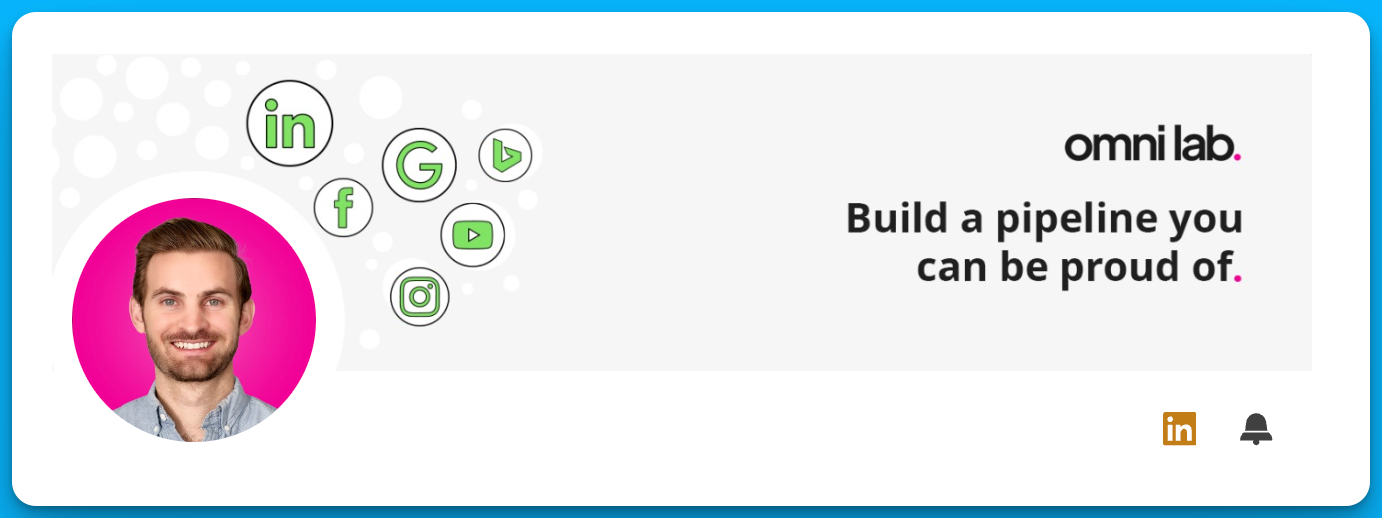
3. Add what you do + the category you play in to your headline

4. Use the About section to explain why your company exists and how you approach things differently (bonus if you can also add a few testimonials)

5. Use the featured section to highlight your core CTA + top performing posts demonstrating your expertise

Tip #7: Look at the right metrics
Let’s say you have all the fundamentals in place: an optimized profile, great content, solid targeting, etc.
Now, the next step is to ask yourself: What metrics should we look at to understand if our content is working?
Here’s what I recommend to my clients:
1. First of all, check your LinkedIn demographics report to make sure that you’re actually reaching your ICP.
2. Check in-platform metrics such as impressions, engagement, and CTR. If these metrics look healthy, you’ll know that your audience is finding value in your content.
3. Look at smaller microconversions, such as engaged visits on your website. Are the people reading your thought leader ads eventually navigating to your site to learn more?
4. Look at the self-reported attribution field on your demo request form. Are more people mentioning your thought leaders? If the answer is yes, you’ll know that your content is building trust with the right people.
5. Finally, you can look at more bottom of funnel metrics, such as sign ups or meetings booked, but ultimately, DO NOT obsess over these metrics. Prioritize numbers 1-4 to understand if your content is resonating – it might take a while to see a significant impact on pipeline and revenue.
Pro Tip: If you’re not sure what content to promote as thought leader ads, look for posts that had a 2-3% CTR organically. In my experience, these posts with a higher organic CTR are also the top performing ads.
Tip #8: Give yourself a reality check
Most people – and B2B buyers especially – aren’t making impulse decisions and can’t be pushed through a funnel.
As the Ehrenberg-Bass Institute has highlighted, if you look at how often prospects make a purchase in your category, you’ll quickly realize how few of the people you’re targeting are actually in-market.
Even if you run the greatest ads in the world, you can’t expect people to schedule a demo if they aren’t actively looking for a solution.
And even if they do book a demo, if you have a higher ACV, you’ll probably have an extremely long sales cycle.
My point is, you can’t expect hundreds of demos or millions in revenue right away.
Tip #9: Put yourself in your buyer’s shoes
This is a fun exercise I like to do with my clients.
I ask: “When you see posts on LinkedIn, what actions do you usually take?”
Usually, the response is something along the lines of:
“I read and keep scrolling…” or “If I like something, I might react or leave a comment…”
Then I ask the follow-up question: “If you see a post you like from a company you’ve never heard of before, would you immediately book a demo?”
And typically the answer is “No, of course I wouldn’t.”
Our prospects aren’t that different than we are; if we wouldn’t buy immediately, they probably won’t either.
If you’re getting good engagement and starting to see other signs of life (such as engaged website visits), you’re headed in the right direction, even if you’re not seeing more demos and sign ups right away.
Tip #10: Focus on Awareness, Not Conversions
Think of thought leader ads as a brand awareness play, not a direct response tactic.
Like any good brand marketing, your thought leader ads should relate to key buying situations, or category entry points.
For example, if I promote posts about how we help our clients improve their lead quality, prospects may think of Omni Lab if they ever run into lead quality issues.
Or maybe I talk about how we use paid media to increase brand awareness, and prospects may think of us if they’re having a brand awareness problem.
The key to succeeding with thought leader ads is putting the right messages in front of the right people. If you do this over a long enough period of time, the pipeline and revenue will follow.
Hope you found this article helpful!
Feel free to reach out on LinkedIn or Omni Lab with any questions about demand gen or paid media.
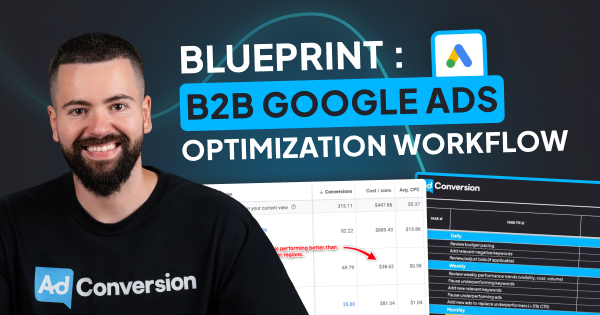
How To Create a B2B Google Ads Optimization Workflow [+Free Template]
Hey there, B2B Marketer. If you don’t have a well-structured optimization workflow, managing just a handful of Google Ads accounts can be a struggle (been there, done that 😅)
In this article, I’ll walk you through the Google Ads Optimization Workflow template, the exact process I used to go from barely managing five Google Ads accounts to easily managing 30+ 🚀
TABLE OF CONTENTS
- Google Ads Optimization Workflow Process
- Daily Google Ads Optimizations
- Weekly Google Ads Optimizations
- Monthly Google Ads Optimizations
- Quarterly Google Ads Optimizations
- Free Resources to Master B2B Ads 🔥
Why You Need a Google Ads Optimization Workflow Process
Without a consistent approach, managing Google Ads can feel chaotic. You may get lost in metrics that don’t matter or, worse, miss out on key optimizations that could boost your profitability.
I developed the Google Ads Optimization Workflow Template to help me stay organized and focus on impactful daily, weekly, monthly, and quarterly optimization tasks.
👉 Grab your free copy of the template in Module 2, Lesson 1 from the B2B Google Ads 102 - How To Convert Clicks Into Profit course.
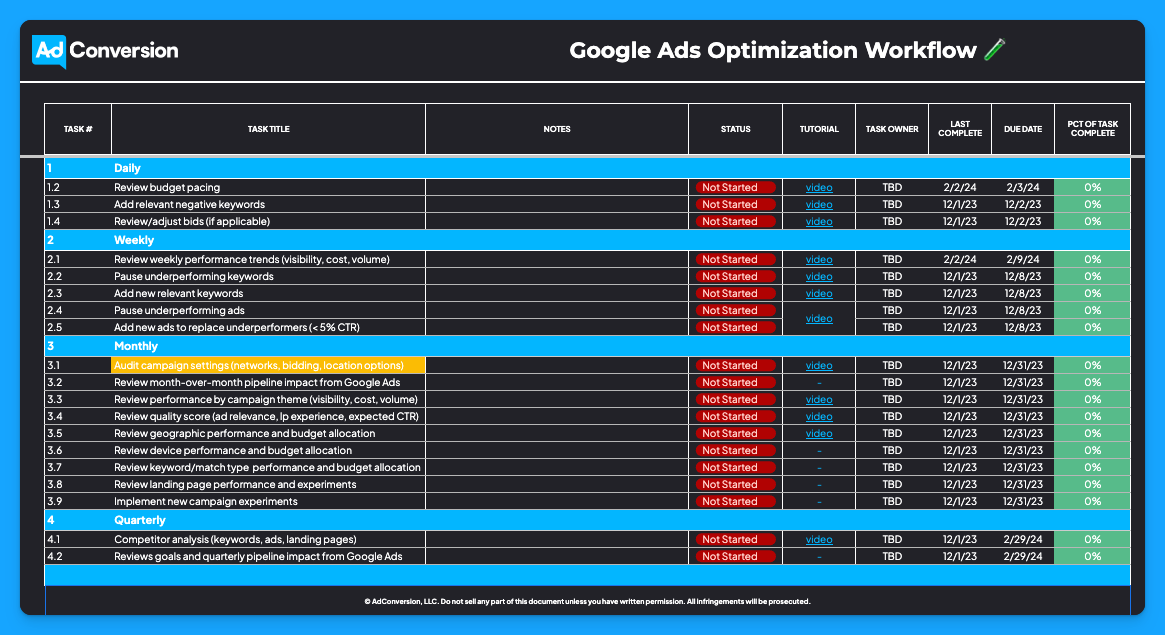
If you follow this approach, you’ll find yourself in control of your accounts, not the other way around.
Now let’s dive deep into the tasks by timeframes ⏰
Daily Google Ads Optimizations
Daily optimizations are essential for ensuring that your accounts are running smoothly. It’s your first line of defense against overspending and wasted ad spending.
Each day, you should:
1. Review your budget pacing
This way, you’ll ensure that you are not overspending or underspending.
2. Check for irrelevant search terms in the Search Terms Report
You want to add any irrelevant negative keywords. So every single day, you should review your search terms report and compare your search terms to your keywords to find the irrelevant ones and add them to your negative list.
3. Adjust bids as needed
If you’re using manual bidding, make sure to adjust your bids accordingly to get visibility.
If you’re using something like maximize clicks with a bid cap, make sure that you take a look at your average cost per click in relation to your bid cap. If you notice that your average cost per click is really close to your bid cap, you could be throttling yourself.

If you’re using Target CPA bidding, ensure that the CPA amount you set is large enough to get enough deliverability. I recommend increasing it by 20% if you notice you’re not spending your budget.
Pro Tip: Setting up Google Calendar reminders can be helpful, and something that I always tell my team that manages client accounts internally at our agency is to block an hour on their calendars every single day to go through their accounts and optimize them. We call it “optimization power hour”. ⚡️

By doing that, you will be proactive, and you’re going to catch things much sooner before they become potential fires.
Weekly Google Ads Optimizations
Weekly optimizations allow you to step back and review broader trends instead of getting caught up in the day-to-day fluctuations.
Instead of getting caught up in the day-to-day fluctuations, here you should:
1. Review weekly performance trends (visibility, cost, volume)
Every week you should look at search impression share, search lost to rank, search lost to budget, and search top impression share.
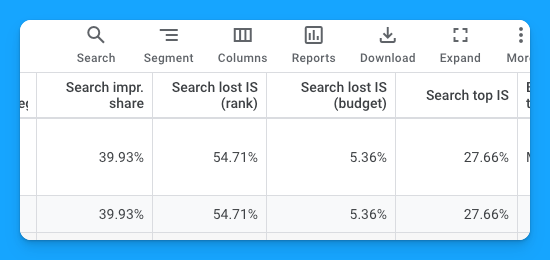
You also want to look at how much you have spent, your cost per conversion, your cost per custom conversion, meaning the cost per SQL, converted user, or whatever that KPI is that you’re measured against.

You will also want to look at volume. How many conversions are you getting? Is it trending up? Is it trending down? These are the things to keep an eye on every week.
Another thing you can do is check the charts in Google Ads to map different metrics and quickly see the trend of search impression share with this graph 👇

🚨Important: When you’re optimizing and looking at things weekly, don’t freak out if you see changes like 25% down search impression share. But if you see it happen consistently for two or three weeks in a row, then there’s definitely something that you need to make a decision about.
Lastly, breaking down your campaigns by themes like brand, non-brand, and competitive will help you to quickly identify underperforming segments and reallocate your budget where it will be most effective.
This will make the optimization process much more manageable.
2. Pause underperforming keywords
Pausing underperforming keywords is an opportunity to give more budget to the keywords with good performance.
You can quickly go to the keyword section in your account and filter by conversions to see which keywords have no conversions. Then, you can sort by cost and understand which ones are hemorrhaging the most budget and can be paused.
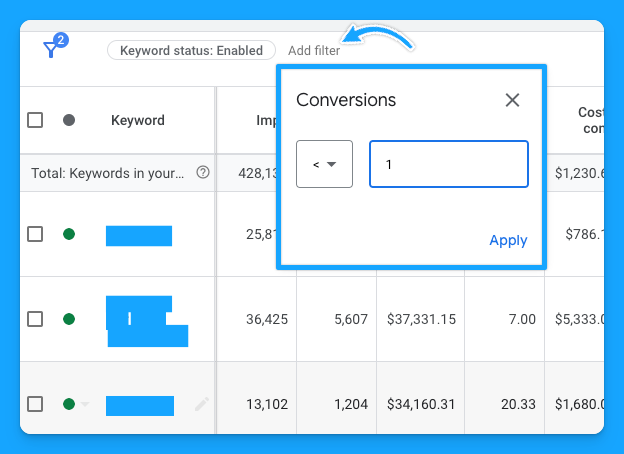
3. Add new relevant keywords
When you check the Search Terms report, there are certain search terms that can make sense to add to your campaign as keywords.
You can also go to the Google Ads Keyword Planner and find net new keywords that you might not be covering. This is an opportunity to expand your scope and reach, and it’s a good best practice to get into the habit.

4. Pause underperforming ads and add new ads to replace underperformers (<5% CTR)
Pausing underperforming ads is as simple as going to the ad section in your account and then pausing any ads that are not performing anymore.
So if you notice you have some underperformers, ideally anything less than a 5% click-through rate (but always compare it with your average performance), it’s time to shut off the underperforming ad and add a new ad into the mix.
This way you can continually improve your overall click-through rate performance to help boost your expected click-through rate and improve your quality score.
Monthly & Quarterly Google Ads Optimizations
Monthly and quarterly tasks focus on more strategic, higher-level adjustments.
Monthly Optimizations
It’s crucial to ensure that your campaign settings, quality score, and budget allocation align with your overall goals and haven’t been altered unintentionally.
This is also the time to assess the impact of your Google Ads efforts on your sales pipeline and to make necessary changes.
So at the end of each month, you should:
👉 Audit campaign settings (networks, bidding, location options)
This step is crucial if you manage multiple campaigns or accounts.
It’s important to double-check if you’re targeting the right network and don’t have display and search combined together.
You want to make sure your bids haven’t been updated by accident, or God forbid, you have the auto recommendations still turned on, and they’re automatically updating your bids without your consent. 💀
You also want to ensure that your location options are set to “presence” and that people are actually in your target location or regularly in, not people who are potentially in other areas and are interested in that location.

👉 Review month-over-month pipeline impact from Google Ads
We’re running ads to generate revenue, and revenue comes from initially having pipeline.
So you need a dashboard to track the performance month-over-month and connect your activity to revenue.
It can be as simple as having a report on a spreadsheet where you can see the evolution of your KPIs every month. You can create one from scratch or search for a template on the internet.
Pro tip: Check out our free Building a Paid Media Program course (Module 3, Lesson 2) to learn how to build an automated dashboard for less than $200/month using Google Sheets + a connector like Dataslayer or Supermetrics.
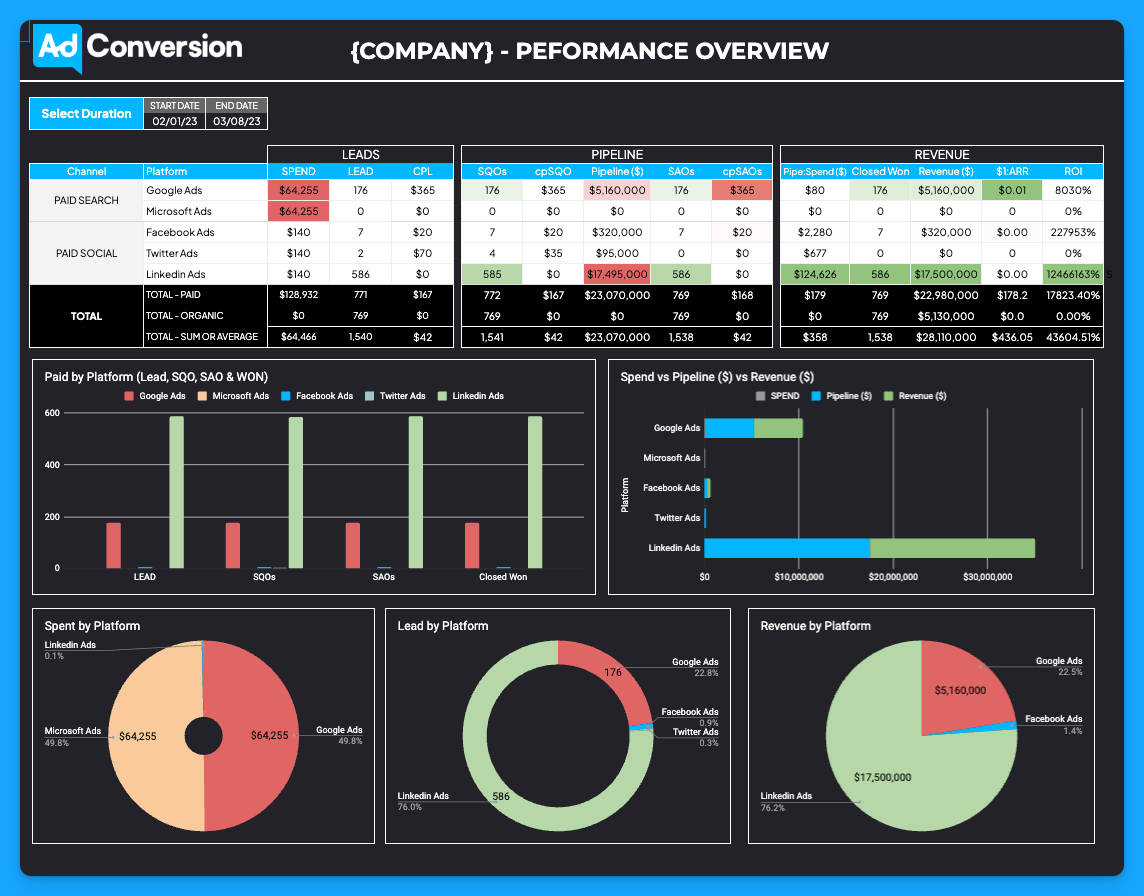
👉 Review performance by campaign theme (visibility, cost, volume)
The same analysis we discussed in the weekly optimizations above should be done on a monthly basis too.
How much are you spending per theme? What is your cost per conversion? What is your conversion rate? And what are the volumes?
Are you driving more volume in a certain theme versus another? Should you move the budget around?
These are the questions you should answer here.
👉 Review quality score (ad relevance, landing page experience, expected CTR)
How is your quality score by campaign theme? Is it increasing or decreasing month-over-month?
Ideally, you should aim for a quality score of 7 or above. If it’s lower than that, optimizing your ad relevance, expected CTR and landing page experience will improve things.
Check out this Quality Score Guide to learn the 80/20 of what you need to know about quality score to improve it.
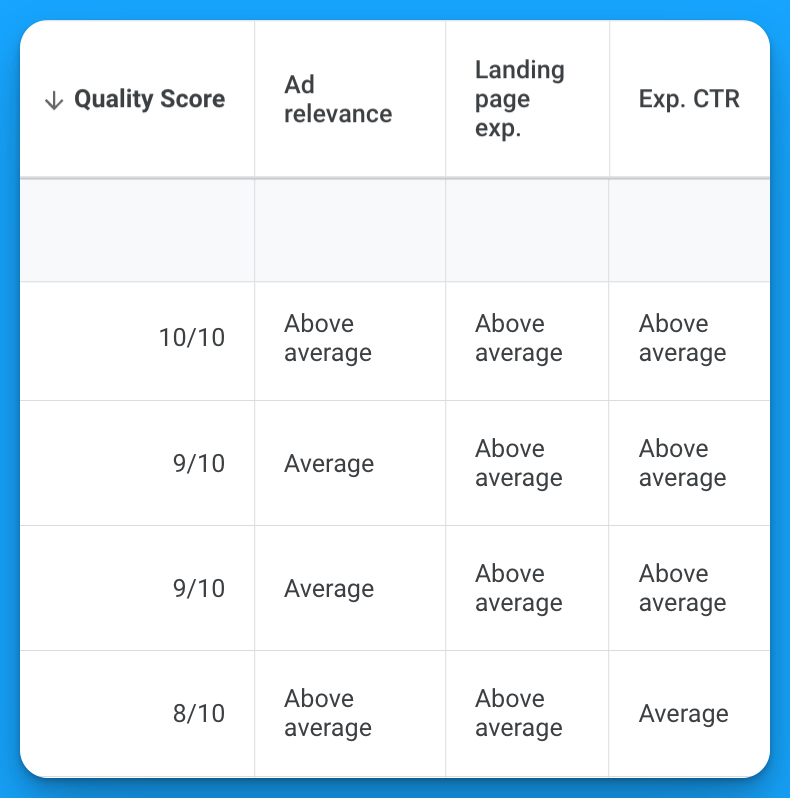
👉 Review geographic performance and budget allocation
Here you want to go ahead and see how the campaigns you’re targeting in each region are performing so you can make the necessary adjustments.
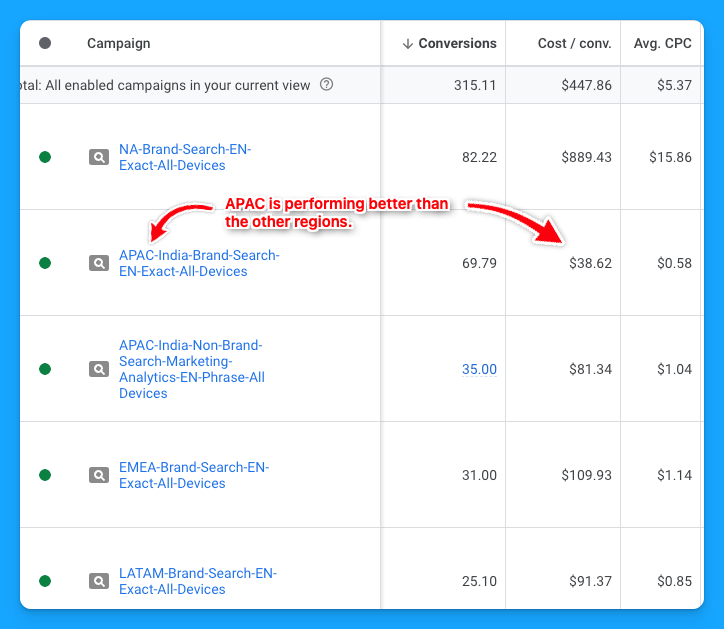
I also recommend checking the Locations report to have a granular view of how each country grouped into a region is performing.
By doing this, you can find opportunities for new campaigns targeting a single country if it has a good performance and the campaign is limited by budget, or excluding low-performing countries to free up some budget for the top performers.
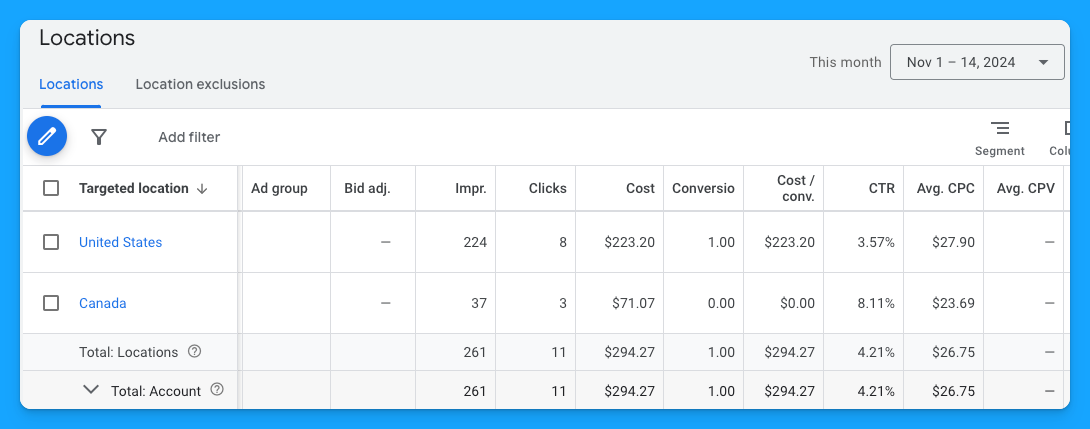
👉 Review device performance and budget allocation
In B2B, desktop usually performs better than mobile and tablet, so if you’re targeting all devices you can find opportunities to maximize conversions by breaking out the campaigns into different devices.

👉 Review keyword/match type performance and budget allocation
Are there certain keywords that are doing better for you than others? Certain match types? All of these are insights that will help you optimize your Google Ads campaigns.
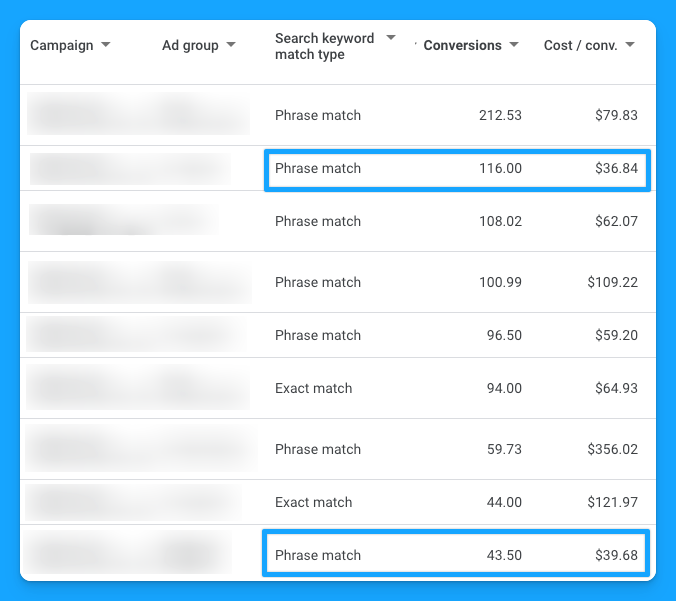
👉 Review landing page performance and experiments
How are your landing pages performing? Are you running experiments? If you're not, that's definitely an opportunity.

👉 Implement new campaign experiments
If you’re not testing new experiments, this is a massive opportunity to improve performance, and you can run experiments easily in Google Ads with their campaign experiments tool.
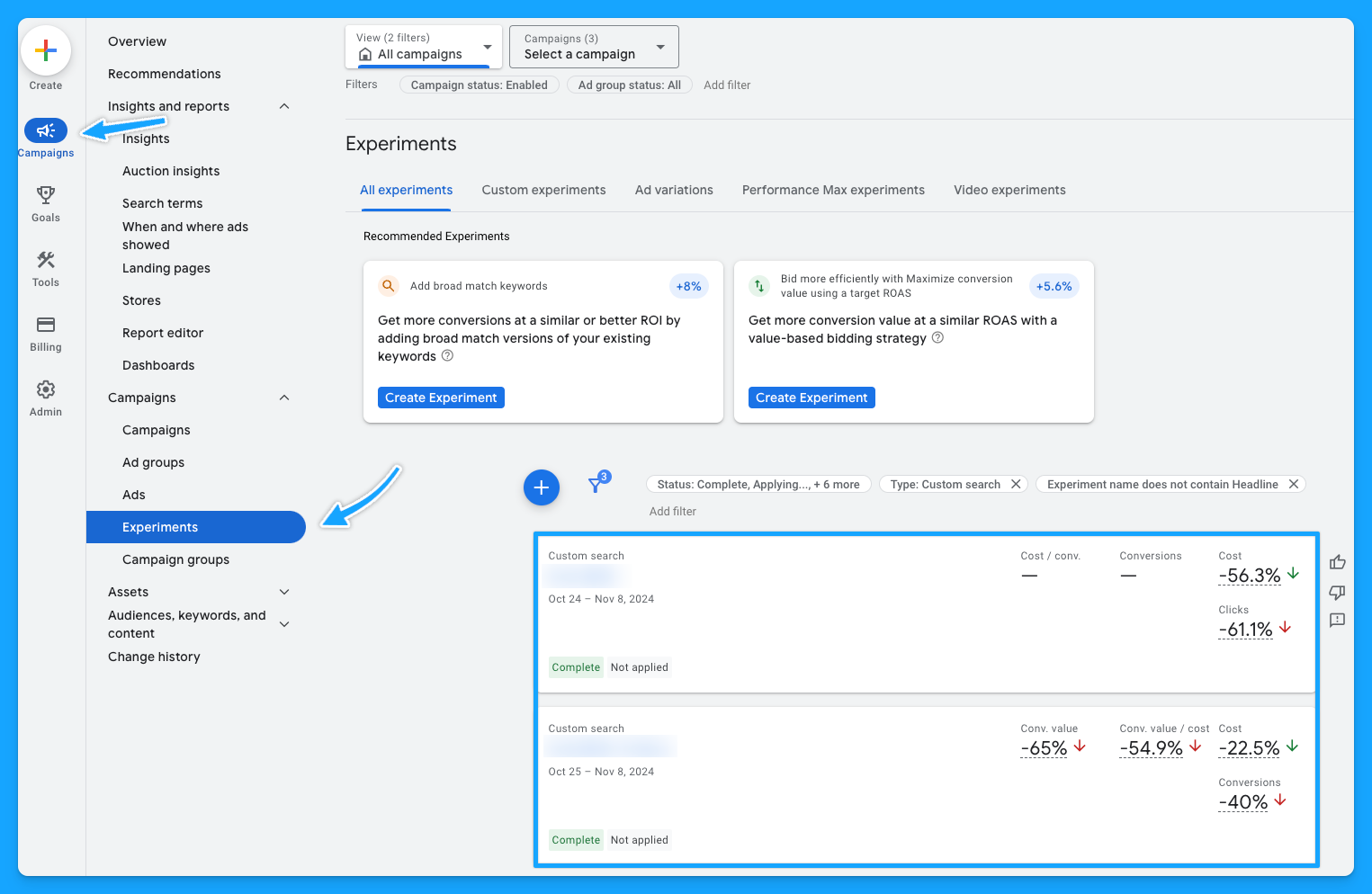
Quarterly Optimizations
Every quarter, take time to conduct a competitor analysis and review your goals. It’s a great practice to see what new ads and keywords your competitors are using, giving you inspiration and helping you stay ahead in the market.
Pro tip: The channel ad libraries are great resources for competitor research. Check out these 10 tips for free competitor research using them.
This periodic check-in will ensure that your optimizations are aligned with your business objectives, providing a clear path for growth 🙌
Stay organized with the Google Ads Optimization Workflow template
If you get your free copy of our Google Ads Optimization Template, you’ll notice that we have daily, weekly, monthly, and quarterly tasks discussed above on the template.
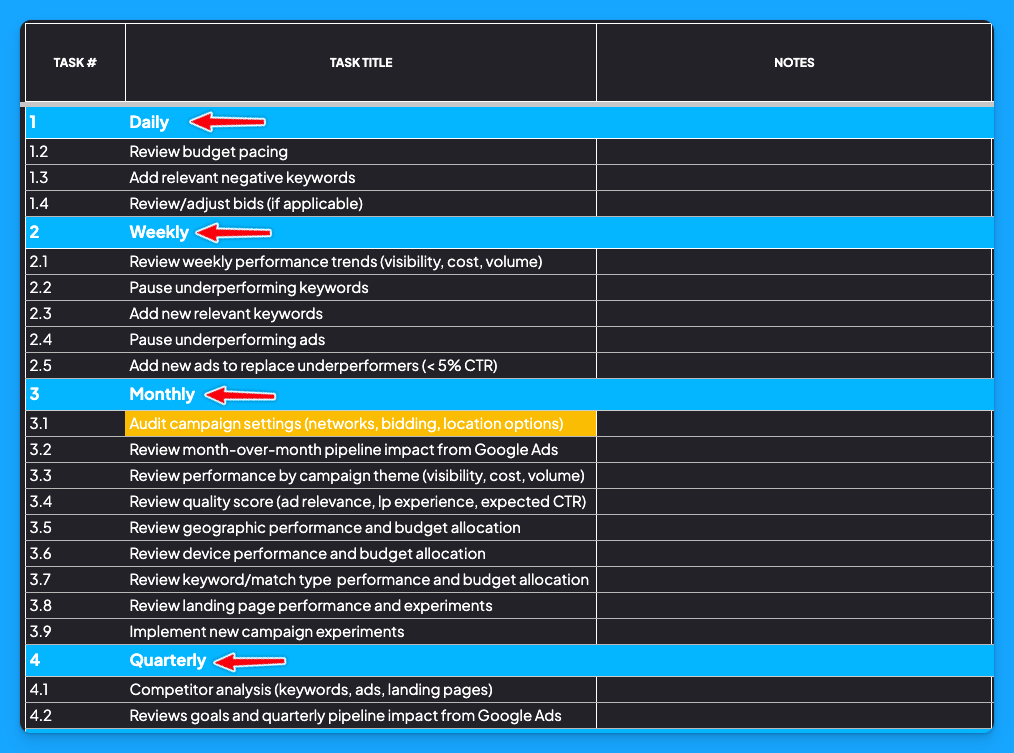
The way this template works is very simple. We have our tasks on the left, the task title, and the different timeframes. There’s also a space for you to take notes while optimizing your account.
Then you can change the status of each task, so you and your team will know if a task is done or if it’s in progress, as well as define the task owner.

There are also some formulas where, based on the timeframe, the due date will automatically update. So for example, if you set the Last Complete date of a daily task as 2/2/24, it’ll automatically say the due date for that task is 2/3/2024.
In addition, if you do the same thing for a weekly task, it will add seven days to the due date, and now it will say 2/9/2024.
Lastly, you’ll also find all the different tutorials covered in this guide linked to each task. The goal of these tutorials is to show you how to do each step so you can use this as a reference.
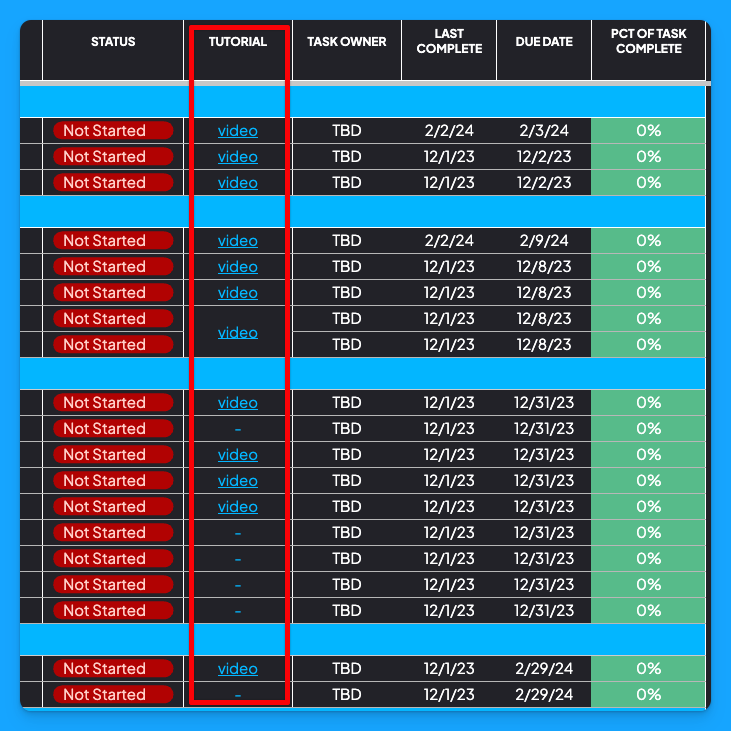
By implementing these daily, weekly, and monthly optimizations, you’ll stay ahead of potential issues and make data-driven adjustments that boost your account performance.
I hope this guide helps you to manage your accounts efficiently 🙌
If you have any questions, feel free to connect with me on LinkedIn.
From Clicks to Conversions: Master Google Ads for B2B 🔥
If you want to become a Google Ads pro, check out our free B2B Google Ads courses, where you'll learn how to launch, optimize, and scale your campaigns to drive pipeline and revenue.

Here's what you'll learn in each course:
⚙️ B2B Google Ads 101 - How to Launch Dangerously Effective Campaigns for Beginners
- The Googleverse: The Game You're Playing & How To Win
- Measurement: How to Make Sure You're Profitable
- Targeting: How to Show Up For the Right Searcher
- Planning: Putting It All Together
🎯 Google Ads 102 - How to Clicks Into Profit
- Visibility: How To Find the Hole Sucking Profits
- Workflows: How to Optimize On a Daily, Weekly, Monthly & Quarterly Basis
- Experimentation: How to Test & Automate Profitability
- Troubleshooting: How To Solve Inevitable Problems
🚀 Google Ads 103 - How to Scale Google Ads For Advanced Advertisers
- Methodology: How to Vertically Scale Google Ads From A-Z
- Campaigns: Scaling Horizontally Through Campaign Themes
- Channels: Scaling Outside of Paid Search
Click Here to Join 1,000+ B2B Marketers Today and start leveling up your advertising skill set.
Takes < 90 seconds to sign up (seriously we timed it 😂)
-2.jpg)
Using the Jobs To Be Done Framework to Maximize Revenue in B2B Ads [+Free Template]
Understanding the Jobs To Be Done framework developed by Tony Ulwick can be confusing and overwhelming because most of the information you’ll find is focused on product development.
In this article, I’m going to unpack the Jobs To Be Done framework from a B2B advertising perspective.
Why? Because identifying what job your customers are truly “hiring” your product or service to do will be the secret to launching a powerful ad campaign.
This article is part of our B2B learning track so if you’re serious about learning B2B advertising you’re in the right place!
Let’s dive into it 👏
TABLE OF CONTENTS:
- Understand Why Customers Choose Your Product
- Using the Jobs to Be Done Interview Matrix Template
- Customize Your Messaging with Personality Insights
- Real Use Case of the JBTB Matrix Template
- Free Resources to Jumpstart Your B2B Marketing Career
Understand Why Customers Choose Your Product
In any industry, people don’t buy products, they invest in solutions to get a job done. It’s not just to buy another thing like your cat-hoarding grandmother. 😅🐈

For B2B marketers, Tony Ulwick’s Jobs to Be Done framework should be focused on why your customers “hire” your product or service, so you can put them and their needs at the heart of your advertising story.
This will help you to identify what pain points you’re helping your customers solve to get to the root of what motivates them because your advertising campaign should be about them — not you.
But how can you do that?
You can use the Jobs To Be Done framework when you're launching a new advertising campaign or when you want to improve the conversion rates of your existing advertising campaigns (aka your ads that aren’t converting)
The most impactful way to start is by identifying three to five recent customers who fit your target market (or Ideal Customer Profile - ICP).
If you need help identifying your ideal customer profile, check out this article: “How to Craft B2B Buyer Personas for Ad Targeting”
Select customers who either recently purchased or have the potential to represent your ideal buyer. These interviews will reveal why they chose your service and what specific pain points you helped them solve.
To make your life easier, I developed a free template called Jobs to Be Done Interview Matrix 🙌
You can find it in Module 2, Lesson 3 of my free B2B Advertising Foundations course, and it’s your roadmap for collecting insights during interviews.
Using the Jobs to Be Done Interview Matrix Template to Gather Actionable Insights

In this JTBD Interview Matrix Template, you’ll be looking for five key points that highlight your customer’s journey with your brand:
- Situation and Pain Points - What challenges are they facing?
- Motivation - Why did they start looking for a solution?
- Trigger - What prompted them to move forward with your service?
- Ideal Outcome - What result are they seeking?
- Competitor Evaluation - What other options were they considering?
The matrix helps you organize answers by each customer’s profile and offers a side-by-side comparison of their unique characteristics.
It also offers 8 helpful interview questions you can use to uncover the right golden nuggets that will make your campaign shine. ✨
Customize Your Messaging with Personality Insights
Finally, understanding your customer’s personality type is like having the key to crafting messaging that lands with confidence.
Resources like Crystal can help you determine each customer’s DISC personality type (Dominance, Influence, Steadiness, Compliance) by scraping their LinkedIn profiles, labelling how they like and prefer to be communicated with, and their style and tone because this will ultimately influence the messaging that you can create for each of your advertising personas.

Here’s a real use case for you to understand each step of the JTBD Interview Matrix
Let’s take Spotify as an example. I love Spotify, so if I were doing an interview with a Spotify customer, it would look like this:

Situation & Pain Points
I get tired of hearing the same songs on the radio. I can’t easily listen to the exact song I want to hear.
Motivation
I want to listen to specific songs when I want
Trigger
I’m in the gym, and I need a song to pump me up
Ideal Outcome
I want to listen to the music I choose, everywhere
Other Solutions/ Products Evaluated – Competitors
Radio, XM Radio, Pandora, Apple Music, Silence
Personality characteristics (DiSC type, DiSC archetype, etc)
Trailblazer - ID. Confident style, with a mix of informality and formality gets their attention.
- Pace: Speak slightly fast. Sounds like a ‘gets shit done’ person.
- Tone: Do not sound too eager, as if you have met a friend suddenly after a long time. Keep the tone calm but confident.
- Tactics To Win: Strong words, focus on results, respectful confidence
Based on the JBT Interview Matrix, here are some Spotify ad examples:


The main takeaway is that you can make your ad campaigns even stronger when you really know what “job” your customers are “hiring” your product or service to take care of.
Use the Jobs To Be Done matrix to dig deep into what matters most to them and adjust your messaging to connect on a personal level. 🙂
I hope you found this article helpful!
Connect with me on LinkedIn, and let’s keep the conversation going.
You can also visit my website here for more valuable content.
Jumpstart Your B2B Marketing Career
If you’re serious about mastering B2B advertising, then you definitely need to check out my free course that will teach you the foundational knowledge to becoming a high-performing B2B marketer who knows how to use advertising to drive legit business and revenue impact without the fluff or wasting your time and money learning the ropes the hard way.
- Module 1: you’ll get a crash course in the B2Bverse and master terminology, sales processes, and working across teams.
- Module 2: you’ll learn how to become your customer's psychologist and understand them deeply with buyer personas that allow you to craft effective messaging.
- Module 3: you’ll master the B2B funnel and learn how to think like a CEO to identify performance bottlenecks and convert more leads into revenue.
- Module 4: you’ll learn how to put it all together and build your go-to-market strategy that gets your ad in front of your dream buyers and converts attention.
This course was designed with absolute beginners in mind.
Accelerate your learning curve and start the course today for free.
How to Create Tracking Templates in Google Ads
Hey there, Digital Marketer. Do you cringe a little when you hear the words “setting up tracking in an ad channel”? 😅
Tracking may be the unsexy side of marketing, but I promise that Google Ads Tracking Templates are simpler than they sound.
In this article, I’ll show you how to set up tracking right, capture accurate data, and see what’s really driving your conversions and revenue.
Let’s dive in! 👇
TABLE OF CONTENTS:
- What is a Google Ads Tracking Template?
- How to install Tracking Templates in Google Ads
- Benefits of adding Tracking Templates to your campaigns
- From clicks to conversions: Master Google Ads for B2B
What is a Google Ads Tracking Template?
Tracking templates allow you to streamline your link tagging process and pass static and dynamic values.
I created this little cheat sheet for you here to give you an understanding of a tracking template.
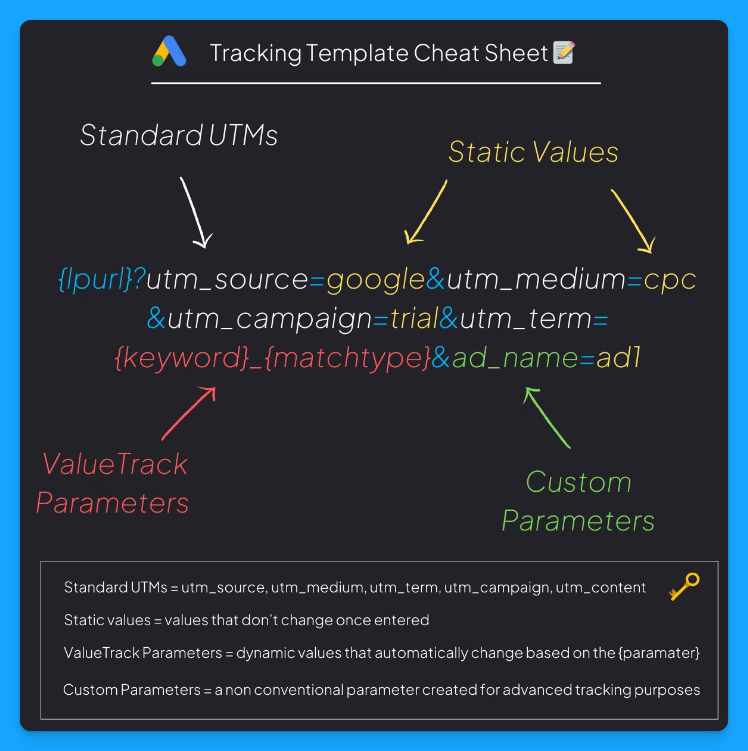
Here’s what each parameter means:
- {lpurl}: This is your landing page URL. So whatever the URL is in your ad, the template will automatically inherit it and then automatically append these different static and dynamic values based on these parameters.
- UTMs: These are your standard UTMs, like UTM source, UTM medium, campaign, term, and content.
Check out our Free UTM Tagger Tool to easily create them in bulk and for more info about each parameter. - Static Values: Static means it’s always the same, it’ll remain consistent. So a static value will always be a text.
So in the image example above, we always want the UTM Source to be google, the UTM Medium to be cpc, and the UTM Campaign to be trial. - Dynamic Values: Dynamic means it changes. The values here usually have squiggly brackets like {keyword} or {matchtype}, which tell Google Ads to populate that field dynamically.
For example, with {keyword}, the UTM Term will automatically insert the keyword that drove the click, giving you granular detail on the search behavior driving each visit. - Custom Parameters: These are parameters you can create that are not part of the UTM parameters, which are your standard ones.
You’ll probably want to use custom UTM parameters if you have some sort of advanced tracking setup.
Anything that is available in the URL, you can then set up with JavaScript the ability to pass the data from those parameters into hidden fields in your form, to then be able to route and track and do all sorts of things in your backend.
In the cheat sheet above, the ad_name parameter will give you details about which ad drove the visit.
So this is a tracking template, and it’s really important as this is going to allow you to get a lot better data and ultimately, better insights from your activities.
How to Install a Tracking Template in Google Ads
You can install a tracking template at the campaign, ad group, or ad level. You could even do it at the account level with the tracking script, but I recommend that you start off at the campaign level.
Here are the steps you need to follow in your Google Ads account 👇
- Open your account, then open the campaigns tab and choose one campaign. Now go into the settings by clicking on this little gear.

- Scroll down to additional settings.

- Go to the Campaign URL options and paste your tracking template in the “Tracking Template” field.

Here you’ll want to follow the format from the cheat sheet I shared at the beginning of this article because that is the syntax of the tracking template.
To be easier, you can copy this tracking template below and just add your static values in the highlighted fields:
{lpurl}?utm_source=entersource&utm_medium=entermedium&utm_campaign=entercampaign&utm_term={keyword}_{matchtype}&ad_name=enteradname
- UTM Source: People usually use Google or AdWords.
- UTM Medium: People usually put CPC or paid search. This 100% depends on you and your business, your company, and how you want to track things.
- UTM Campaign: You can put the name of your campaign. The downside is that you have to do this for each campaign.
- UTM Term: This will dynamically push the keyword that drove the click and the match type.
- Ad_Name (custom parameter): This is 100% optional, and most of the clients from our agency don’t really need custom parameters, but I just want you to be aware of it.
Once you’ve mastered basic tracking, custom parameters can add another layer of insights by capturing non-standard data. For instance, if you want to differentiate ad variations, you could set a custom parameter like ad_name=RSA1.
You can also find all the Value Track Parameters Google supports here:
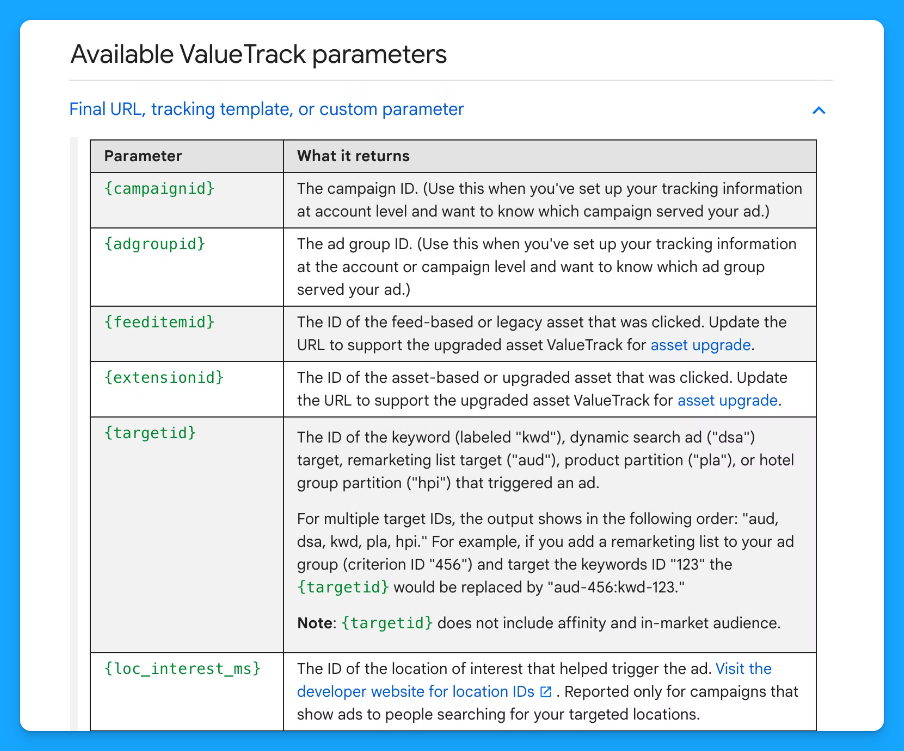
I usually like to set my tracking templates at the campaign level, which suffices. So, in this case, each campaign must have a unique tracking template.
Another cool thing about the tracking template is once you create the tracking template at the campaign level, you no longer have to worry about tagging your ads with UTM parameters at the ad level.
It'll automatically inherit the campaign URL tracking template and tag your links appropriately.
If you're just putting all of the tagged URLs at the ad level, it can be really problematic sometimes and time-consuming to make changes and miss things. This helps streamline things and push those dynamic parameters.
Benefits of Adding Tracking Templates to Your Campaigns
Setting up tracking templates in Google Ads is a powerful way to automate link tagging and capture high-quality data.
The better data we pass through our tracking template, the more insights we can receive.
With standard UTMs, dynamic parameters, and custom fields, you’ll get a clear view of what’s driving performance and find better ways to allocate budget, optimize campaigns, and ultimately boost results. 🚀
Why deny yourself incredible insights such as “which keywords drive the most revenue?..” when you can capture that information at no additional cost?
That’s it about tracking templates! 🎉
Now go build your first one and let the data guide your ad strategies! 🤓
I hope you found this article useful!
From Clicks to Conversions: Master Google Ads for B2B 🔥
If you want to become a Google Ads pro, check out our free B2B Google Ads courses, where you'll learn how to launch, optimize, and scale your campaigns to drive pipeline and revenue.

Here's what you'll learn in each course:
⚙️ B2B Google Ads 101 - How to Launch Dangerously Effective Campaigns for Beginners
- The Googleverse: The Game You're Playing & How To Win
- Measurement: How to Make Sure You're Profitable
- Targeting: How to Show Up For the Right Searcher
- Planning: Putting It All Together
🎯 Google Ads 102 - How to Clicks Into Profit
- Visibility: How To Find the Hole Sucking Profits
- Workflows: How to Optimize On a Daily, Weekly, Monthly & Quarterly Basis
- Experimentation: How to Test & Automate Profitability
- Troubleshooting: How To Solve Inevitable Problems
🚀 Google Ads 103 - How to Scale Google Ads For Advanced Advertisers
- Methodology: How to Vertically Scale Google Ads From A-Z
- Campaigns: Scaling Horizontally Through Campaign Themes
- Channels: Scaling Outside of Paid Search
Click Here to Join 1,000+ B2B Marketers Today and start leveling up your advertising skill set.
Takes < 90 seconds to sign up (seriously we timed it 😂)
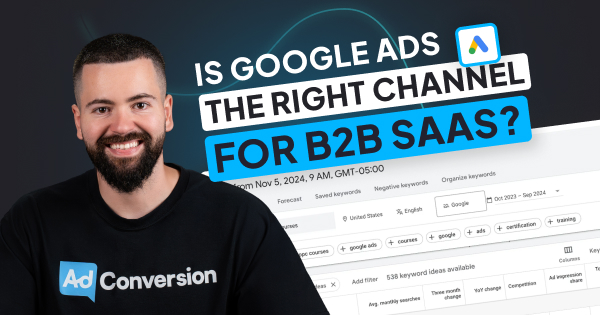
B2B Google Ads: How To Know If Google Is The Right Channel For Your SaaS
Hey there B2B SaaS marketer! Are you getting FOMO around Google Ads?
Every day thousands of SaaS businesses are converting clicks into profitable pipeline on Google Ads, and conversely thousands are burning clicks into wasted ad budgets.
After $10M in Google Ads spend management for incredible SaaS companies like ActiveCampaign, Mixpanel, and others, I’ve developed a criteria for Google Ads success.
I call it the Google Ads Sweet Spot. If you want Google to be a significant driver in your pipeline generation you need to make sure your SaaS company checks these 3 criteria.
After reviewing, it’ll be clear if Google is right for you, let’s dive into it 👇
TABLE OF CONTENTS:
Proven Concept
The first criteria in the Google Ads Sweet Spot is a Proven Concept.
You see, in order to succeed with Google Ads your product has to be built on a time-tested and proven concept.
Imagine running Google ads for a generative AI product before the invention of ChatGPT.
Because AI products still hadn’t gained popularity, you probably would have struggled to generate sufficient searches and clicks on your ads.
If you create an innovative product in a new category that no one understands, you likely won’t see a great return on effort from Google.
In this case, it’d make more sense to focus on educating the market about the problem you solve via demand gen channels such as paid and organic social.
Existing Demand
The second criteria of the Google Ads Sweet Spot is Existing Demand.
This is directly connected to the first criteria: you won’t generate pipeline or revenue if people aren’t actively looking for your solution.
If you only have, for example, 100 people searching for your product every month, it’s going to be impossible to generate significant results from Google.
For example, assuming the industry average conversion rate of 3%, and 5% clickthrough rate (CTR) you’re looking at 5 clicks from the 100 impressions, and you need a minimum of 33 clicks to generate a single lead. At 100 impressions/month it will take you six and a half months to generate ONE lead 🤯– extreme example but I hope you get the point.
You need enough search volume, so you have enough clicks, and ultimately conversions.
To verify that you have sufficient search volume, you can use the Google Ads keyword planner.
Let’s say you want to bid on the term Google Ads courses within the United States. You can see that there are approximately 2,900 searches every month for this specific term, which validates that there’s sufficient search volume to have a chance at success.
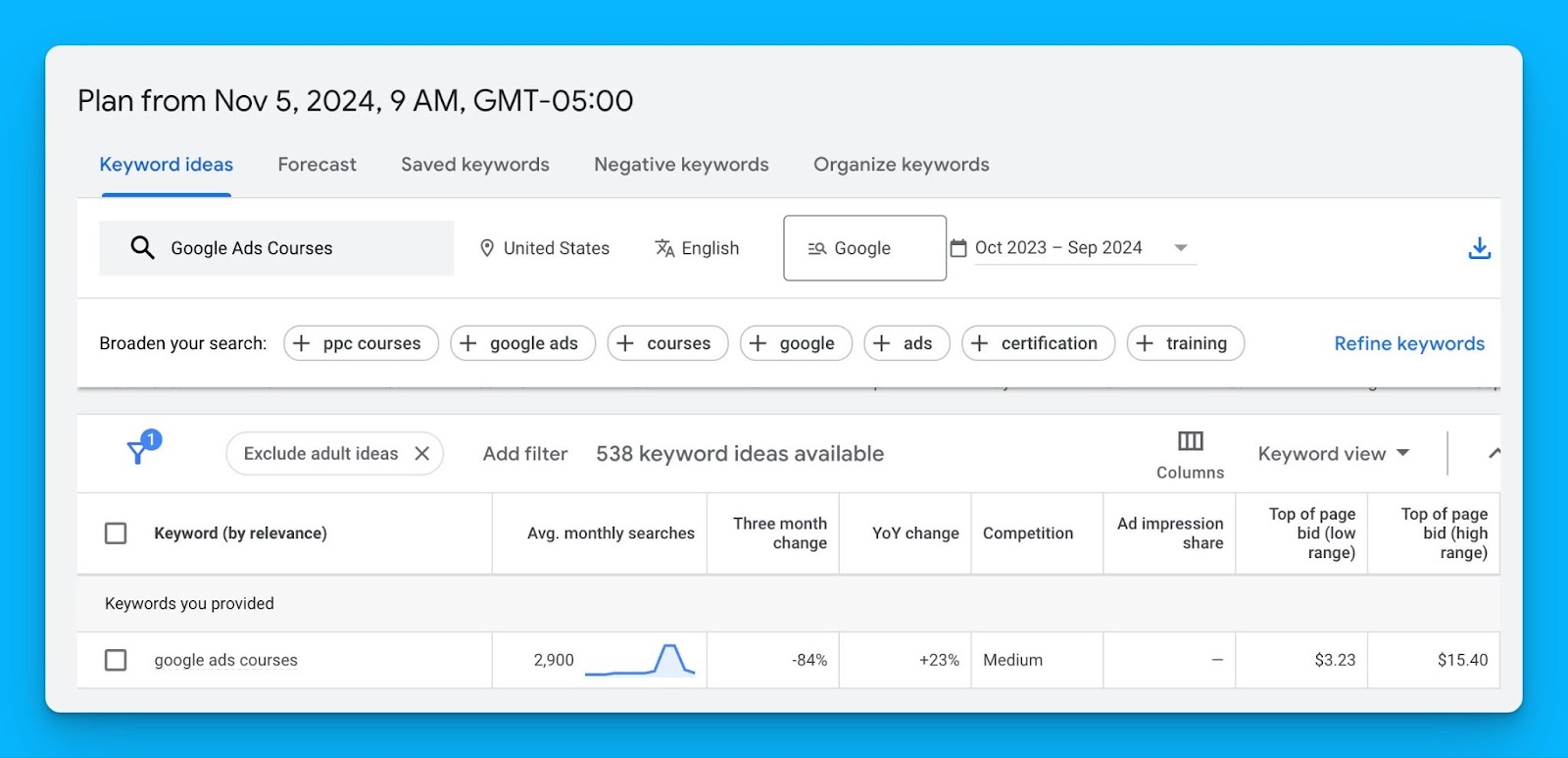
Keep in mind monthly searches in the keyword planner are just an average and always changing – use them to inform your estimates but take them with a grain of salt.
Sufficient Margin
The third criteria of the Google Ads Sweet Spot is Sufficient Margin.
You SHOULD NOT run Google Ads if you don’t have enough margin, or in other words, a high enough lifetime value (LTV) to offset acquisition costs. Without a high enough LTV, Google will never become a profitable channel for your company.
Here’s an example:
Let’s say you have an LTV of $100 per user, and your average cost per click is $10. In this case, the likelihood of running profitable campaigns is slim – you’d have to convert 10% of your total traffic just to break even 😅 (when the industry average conv rate is 3-5%).
If you’re selling a variety of products and you have a small budget (<$10K/month), I recommend running ads for the products with the highest lifetime value to maximize your chances of profitability.
If your campaigns aren’t profitable right away, that’s okay, as long as you know you’ll recoup your investment 3-6 months down the line.
If you want to see if the math adds up to run Google Ads profitably for your company, check out our free Google Ads Budget calculator.
I hope you found this article helpful!
Google Ads definitely is not for everyone but if your SaaS meets these three criteria your chances of success are far greater than not based on my experience.
If you have any questions, feel free to connect with me on LinkedIn.
From Clicks to Conversions: Master Google Ads for B2B 🔥
If you want to become a Google Ads pro, check out our free B2B Google Ads courses, where you'll learn how to launch, optimize, and scale your campaigns to drive pipeline and revenue.

Here's what you'll learn in each course:
⚙️ B2B Google Ads 101 - How to Launch Dangerously Effective Campaigns for Beginners
- The Googleverse: The Game You're Playing & How To Win
- Measurement: How to Make Sure You're Profitable
- Targeting: How to Show Up For the Right Searcher
- Planning: Putting It All Together
🎯 Google Ads 102 - How to Clicks Into Profit
- Visibility: How To Find the Hole Sucking Profits
- Workflows: How to Optimize On a Daily, Weekly, Monthly & Quarterly Basis
- Experimentation: How to Test & Automate Profitability
- Troubleshooting: How To Solve Inevitable Problems
🚀 Google Ads 103 - How to Scale Google Ads For Advanced Advertisers
- Methodology: How to Vertically Scale Google Ads From A-Z
- Campaigns: Scaling Horizontally Through Campaign Themes
- Channels: Scaling Outside of Paid Search
Click Here to Join 1,000+ B2B Marketers Today and start leveling up your advertising skill set.
Takes < 90 seconds to sign up (seriously we timed it 😂)

10 Tips to Create B2B Ads that Convert
If you want your ads to drive conversions, you need the right messaging, positioning, design, tone, format, offer, etc.
This is especially true in B2B, where pushing prospects from initial awareness to conversion is extremely challenging.
Below are my top 10 tips to maximize your chances of success, based on my own experience working with dozens of B2B clients.
TABLE OF CONTENTS:
- Tip #1: Figure out what you want to say
- Tip #2: Don't use big words or acronyms
- Tip #3: Make it quick
- Tip #4: Use visuals that make your ad stand out
- Tip #5: Create ads that don't look like ads
- Tip #6: Steal from the greats
- Tip #7: Use powerful hooks
- Tip #8: Take up as much space as possible
- Tip #9: Speak like a human
- Tip #10: Stay in tune with what your customer wants
Tip #1: Figure out what you want to say
This might sound obvious, but before creating any ad, you should get extremely clear on the problem your company solves.
All of your messaging should come back to this problem.
If you’re running case study ads, the case studies should be related to this problem.
If you’re promoting a GIF of your product, the animation should help tell the story of how you solve that problem.
As Eugene Schwartz said: The objective of advertising is to highlight a problem and demonstrate how you can solve it.
Here’s a template I like using with my clients to clearly articulate the problems they solve.
Tip #2: Don’t use big words or acronyms
The more simple you keep your ads, the better they’ll perform.
There’s no need to drop in words like CAC, ROI, or ARPU into your copy. Acronyms are poo.
Even if you’re talking about complex topics, aim to keep your explanation simple.
Also, keep in mind, it’s impossible to explain everything about your company in a single ad.
To fully understand what you do, a prospect might need to see 20, 30, or 40 different ads, highlighting what you do in different ways.
Think of the ads in your cold layer as an icebreaker.
The idea is to communicate the basics of what you do in a simple and interesting way – not to tell your entire story.

Here’s an ad we made at Revenu for a client, to do exactly that.
Tip #3: Make it quick
Prospects should know exactly what they’re signing up for in 3 steps or less.
We followed that formula for this ad we made for another client.

With very few words, you can easily understand the benefits of the product.
And if you’re thinking: There’s no way I could explain my offer in 3 steps or less… you need to simplify your process.
When you truly understand your product story, it’s easy to simplify it. That’s where the first tip comes in.
Tip #4: Use visuals that make your ad stand out
A picture is worth a thousand words.
Ads that are filled with words don’t grab a users attention.
Think about what you’re trying to say, and how you can visualise it.
You can see how we did this for Scytale below.
It’s a fairly typical advert, but the way it’s broken out visually makes it much easier to digest.

Pro tip: If you’re only using static image ads, try GIFs. Making something move makes people click it more… simples.
Tip #5: Create ads that don’t look like ads
Want to triple your CTR? Make an advert that doesn’t look like an advert.
Once you get a ton of clicks, you can then retarget them with more product-focused messaging, but they’ve now been introduced to your brand.
To create these types of ads, think of the things that you do on a daily basis. For example, listening to Spotify, watching Netflix, playing chess or other online games, etc. How can you incorporate these everyday concepts into your ads, so that they feel natural and less promotional?
Also, think of the memes that make you laugh while you’re scrolling through different social platforms. Can you create versions of these that are related to the problem your company solves?
Here are a few examples we made for inspiration:



P.S. If you want more examples, check out my Sexy Ads Library, which contains over 300 of my favorite ads.
Tip #6: Steal from the greats
As Pablo Picasso once said, “Good artists copy, great artists steal.”
Lately I’ve been diving into B2C ads to find inspiration for B2B, from companies like Porsche, Land Rover, McDonald’s, etc.
It’s extremely hard to create amazing ads if you’re starting with a blank canvas.
Here are a few great examples:


P.S. I’ll be dropping a new library on my LinkedIn soon with tons of B2C examples, drop me a follow to be the first to see it.
Tip #7: Use powerful hooks
To perform well, your ads need to have powerful hooks.
In other words, you need to give your prospects a very specific reason to take action.
Are you offering an incentive to take a meeting, such as a gift card, free lunch, or free coffee?
Are you sharing a company resource, such as ad credits, a price promotion, or a software add-on?
Are you providing knowledge, in the form of a consultation, an audit, a workshop, etc.?
If you don’t give your prospects an obvious reason to take action, they probably won’t.
P.S. The hooks with the highest conversion rates are typically ones related to your unique company knowledge and resources. Check out a great example from Google below…

And this great visual from Cognism, making a joke about gift card ads.

P.S. Don’t get discouraged if your offer isn’t working the first time around – most companies have to experiment with multiple approaches before they find one that works. And when you do, it’s your main driver of new business for the next 5 years.
Tip #8: Take up as much space as possible
Ads that take up more space on the screen are more likely to stop the scroll, and typically perform better.
On LinkedIn Ads, square images (1200X1200) usually perform much better than rectangular images (1200X628).
Test vertical images (628X1200) that only appear on mobile too.
This ad we made got a CTR in the 2%+ range on LinkedIn, with a CPC in the $3-6 range.

This tip also applies to Google Ads. Make sure you’re using ad extensions to take up more space on the SERP and increase the chances of getting a click.
P.S. If you’re curious about the ad specs you can use across different platforms, check out this comprehensive guide.
Tip #9: Speak like a human
When you’re writing ads for social, make sure you don’t sound like a company.
Be human – friendly, silly, colloquial, personable.
You’re literally on a social media platform… be sociable.
Influencers have all the power these days, because people want to hear from real individuals with a real personality.
So if you want people to listen to you, you need to sound like a human.
These ads we made follow that exact tone, and it’s much nicer to read.


P.S. Some companies have a more professional and corporate tone of voice, but that doesn’t mean you can’t be clear and straight to the point. There are ways of sounding human, without being cheeky.
Tip #10: Stay in tune with what your customer wants
Even if you follow tips 1-9, you’ll still fail if your story is crap.
The world is constantly changing. Over time, the problem you solve may stop being a problem. Or another company may solve it for a fraction of the cost.
When these changes happen, you need to update your product and story in order to stay relevant.
To verify that the problems you solve are important, talk to your customers and interview companies in your ICP that aren’t working with you.
- How much of a problem is XYZ to you?
- Are you currently solving XYZ problem?
- How are you solving it?
- Be honest, would you use our product to solve it?
- If not, why?
- Do you use another company to solve this problem instead?
- How much do you pay them?
Asking these questions will help you verify that your product and story make sense.
Pro tip: In addition to qualitative feedback from customer interviews, you can ask your G2 rep for an export of all your reviews and upload it into ChatGPT. Then, you can ask ChatGPT to identify the top pain points and benefits that are mentioned, which will help you further understand the problems your company solves.
Hope you found this article helpful!
Feel free to reach out on LinkedIn with any questions.
Resources for mastering B2B advertising
If you’re serious about mastering B2B advertising then you definitely need to join 1,000+ B2B marketers leveling up their paid advertising skill sets in AdConversion.
Here’s 4 reasons why you should consider joining. Every one of our on-demand courses are:
✅ 100% free access.
✅ Taught by vetted industry experts.
✅ Have workbooks, resources, and templates.
✅ Less than 10 minutes per lesson.
We believe every marketer should know how to scale paid ads so they can:
- Scale their ideas
- Level up their careers
- Make a positive impact
Click Here to Join 1,000+ B2B Marketers Today and start leveling up your advertising skill set.
Takes < 90 seconds to sign up (seriously we timed it 😂)

10 Tips to Align Your Content and Paid Media Strategy
Over the past decade, I’ve led content marketing for multiple B2B SaaS companies, and I’ve noticed a common problem:
Content marketers and performance marketers rarely communicate.
This leads to inconsistent targeting, positioning, and messaging, which ultimately leads to lackluster results.
If you want to hit your revenue targets, your content and paid media strategies need to be part of the same equation, not completely separate entities.
Below are my top 10 tips on how to get aligned with your content team.
TABLE OF CONTENTS:
- Tip #1: Don't Create "Ads"
- Tip #2: Repurpose the content you already have
- Tip #3: Use paid media to guarantee distribution
- Tip #4: Have a clear POV
- Tip #5: Make sure you have consistent messaging
- Tip #6: Don't be afraid to be different
- Tip #7: Leverage user-generated content
- Tip #8: Share the right content for the right stage of the customer journey
- Tip #9: Leverage retargeting
- Tip #10: Be willing to adapt and change as you learn
Tip #1: Don’t Create “Ads”
It’s easy to fall into the trap of researching the ads of your competitors and trying to mimic them. Or creating ads with a preconceived idea of what an ad should look like.
But at this point, we’re all hardwired to scroll past the ads in our feed.
Ironically, in order to stop the scroll, your ads have to blend in with other organic content.
If you create great organic posts that are educational, memorable, and enjoyable, they’ll probably also perform well as ads.
Tip #2: Repurpose the content you already have
Are there carousels, newsletters, or podcasts that have performed well for you in the past?
Revisit this content.
Why do you think it performed well? How can you remix it to extend its longevity?
One caveat here: Just because something has performed well in the past doesn’t mean you should run it as an ad.
For ads, I recommend repurposing the content that has performed well AND:
- Has a clear POV
- Is consistent with your other content themes
- Is related in some capacity to what your company does
Otherwise, you may end up confusing your audience.
Tip #3: Use paid media to guarantee distribution
We need to stop seeing paid media as something separate from content.
Great ads are just incredible content with guaranteed distribution to the right people.
If you’re running ads, make sure you’re constantly talking to the content marketers on your team to understand what’s working.
What pieces of content are getting the most engagement, communicating important messages, or telling valuable stories?
Is there an opportunity to put money behind this content?
It’s hard to create winning ads if your team is working in silos.
Tip #4: Have a clear POV
There are so many ads that feel and sound the same.
Even if they're creative, they don’t feel different because they lack a unique POV.
What’s the core idea that you want to communicate to your audience?
How is your perspective or approach different from that of every other company?
If you’re not communicating this, your audience will forget about you almost immediately.
P.S. Don’t be afraid to have a slightly more controversial POV, as long as it makes sense for your brand. Sometimes, taking that risk is necessary in order to be memorable.
Tip #5: Make sure you have consistent messaging
When it comes to messaging, you shouldn’t be throwing spaghetti at the wall.
Instead, you should be repeating yourself constantly. Sharing your core message in different ways so that people can easily understand what you do.
A lot of marketers are afraid of repeating themselves. But in order for you to be known, liked, and trusted at scale, repetition is essential.
If you think of the brands that you trust, you’ve probably heard their core message millions of times, maybe without even realizing.
Tip #6: Don’t be afraid to be different
In order to succeed, you need to be interesting, and do things that other companies aren’t doing.
There’s so much noise these days.
If you’re running ads, everybody else is.
If you’re creating content, everybody else is.
So, ask yourself, what can you do that’s different?
Why should prospects pay attention to you instead of other companies in your space?
Look at what everybody else is doing. Is there an opportunity for you to do the opposite?
You have to be willing to take calculated risks in order to stand out.
Tip #7: Leverage user-generated content
User-generated content is a powerful and underutilized tactic to build trust with your prospects.
Do you have video testimonials or celebratory screenshots from your clients?
This is great for both organic content and ads.
Having testimonials from real people comes across as more authentic than the standard G2 reviews that everyone else uses.
P.S. I know it can be nerve-wracking to ask for testimonials, but I’ve found that clients are usually happy to help – all you have to do is send a simple email or LinkedIn DM. And if you work at a larger org, you can talk to your customer advisory board, or ask your sales or CS team to make the ask.
Tip #8: Share the right content for the right stage of the customer journey
A lot of companies make the mistake of promoting the same content to every single prospect, without considering what stage of the buyer’s journey they’re in.
If someone’s already heard of your brand and interacted with your company multiple times, they’ll likely want to learn more about your product features, and may even be interested in a demo.
But if someone has never heard of you before, they probably won’t be interested.
If you’re targeting a completely cold audience, your priority should be to educate them about the problems you solve, not to generate conversions right away.
The reality is – especially in B2B – the demos you get now are a product of the work you did 6 months ago.
P.S. There are no shortcuts when it comes to building trust. Sure, you can use an intent provider and target people who are technically in-market, but typically, even those people need to see more content before requesting a demo.
Tip #9: Leverage retargeting
By retargeting, I don’t mean offering a demo to every single person that has interacted with your brand.
A lot of people in your retargeting audiences won’t be ready for a demo yet.
But they might be interested in attending your event or joining your webinar. Or they might want to learn more about your product, hear from your thought leaders, see testimonials from similar companies, etc.
What interactions have the people in your retargeting audience taken?
Based on these actions, what type of content do you think they’d be most interested in seeing?
It’s important to do this exercise to create a positive experience for your prospects.
If all you do is offer demos they’ll get tired of you pretty quickly.
Pro tip: Think of your retargeting audience as a newsletter that prospects didn’t opt into. Just like a newsletter, you need a mix of different content to grow the trust of your audience over time.
Tip #10: Be willing to adapt and change as you learn
In both content and advertising, it’s important to create a strategy that’s firm but flexible.
It’s great to have a general plan in place, but it shouldn’t be an immovable object.
You have to be willing to adapt based on your audience’s response.
Are there certain messages that are resonating more?
Are there certain formats that are performing better?
Are there certain audience segments that are expressing more interest in your product?
Based on this feedback, you may have to modify your approach.
Hope you found this article helpful!
Feel free to reach out on LinkedIn with any questions about content strategy or distribution.
Resources for mastering B2B advertising
If you’re serious about mastering B2B advertising then you definitely need to join 1,000+ B2B marketers leveling up their paid advertising skill sets in AdConversion.
Here’s 4 reasons why you should consider joining. Every one of our on-demand courses are:
✅ 100% free access.
✅ Taught by vetted industry experts.
✅ Have workbooks, resources, and templates.
✅ Less than 10 minutes per lesson.
We believe every marketer should know how to scale paid ads so they can:
- Scale their ideas
- Level up their careers
- Make a positive impact
Click Here to Join 1,000+ B2B Marketers Today and start leveling up your advertising skill set.
Takes < 90 seconds to sign up (seriously we timed it 😂)
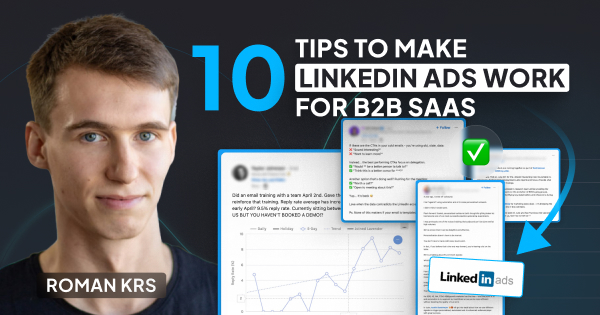
10 Tips to Make LinkedIn Ads Work for B2B SaaS
Over the past few years, I’ve helped dozens of B2B SaaS companies develop their LinkedIn Ads strategy.
Below, I’ll be sharing ten tips that I always give to my own clients, and that will significantly increase your chances of success with LinkedIn Ads 👇
TABLE OF CONTENTS:
- Tip #1: Research Your Customers
- Tip #2: Define Your Targeting
- Tip #3: Distribute Your Content
- Tip #4: Repurpose Your Content
- Tip #5: Test Lead Gen alongside ungated content
- Tip #6: Capture Demand With Retargeting
- Tip #7: Use Text and Spotlight Ads
- Tip #8: Leverage your SMEs for thought leader ads
- Tip #9: Set up the right tracking combination
- Tip #10: Make a commitment of at least 6 months
Tip #1: Research Your Customers
As a marketer, it can be challenging to fully understand your customers, especially since you’re not in direct contact with them.
In order to gain a better understanding, it’s a great idea to watch 3-5 sales calls, recommended to you by the Head of Sales.
Analyze how your sales team is presenting the product to make sure your messaging is aligned.
In addition to this, you can pull transcripts and summaries from hundreds of calls and have ChatGPT develop a content matrix and empathy map for you, summarizing the top pain points of your prospects.
Here is a templatized example of the outcome. ChatGPT can pull it out in this format based on the call summaries and give you a good foundation of commonalities for different prospects.
Once you’ve identified the top pain points and topics with the help of ChatGPT, send them over to a few people on your sales team to validate them. It can be very subjective but can help you to ensure that you haven’t missed any important nuances.
Tip #2: Define Your Targeting
Next, define your targeting.
What job titles, job functions, industries, and company sizes do you want to target?
Once you’ve drafted your audiences, you can share and refine with your stakeholders.
To start out, you can use a simple targeting combination such as Job titles + Company Sizes + Industries.
If your audience is too small using only job titles, you could substitute for Job Function + Seniority + Skills.
A few additional notes:
1. Make sure to check the audience insights section of LinkedIn Campaign Manager to find exclusions that you could potentially make. (video walkthrough)
2. If you have multiple personas, make sure to separate them into different campaigns so you can tailor your messaging.
3. There is no ideal audience size on LinkedIn Ads – small audiences of 10K can work well and larger audiences of 100K can also work well. Start by targeting your ideal customers, and you can expand over time.
Recommendation: Use a validated company list for better targeting and reporting.
Tip #3: Distribute Your Content
Once you’ve set up your audience, the next step is to distribute content towards them.
I highly recommend optimizing your ads for in-feed consumption – talk about the problems you solve directly in your ad copy.
This way, even if people don’t visit your landing page right away, they’ll still be learning about your company and can be retargeted later down the line with a more bottom of funnel offer.
Videos are a particularly great format for delivering these in-feed messages, and they also allow you to generate large retargeting pools.
When you run these ads, look at your impressions and views to make sure that you’re reaching your ICP. And check your engagement rate and dwell time metrics to ensure that the content is resonating.
Don’t expect demos or trials right away – the goal of these ads is to start generating some initial interest.
Tip #4: Repurpose Your Content
Do you have any great podcast or webinar clips related to your solution?
Has anyone on your team created a product demo walkthrough recently?
Do you have any customer testimonials from recent events?
This type of content can be easily repurposed for ads, and is great for both generating and capturing demand.
Before you start creating new content, look at the content that you already have.
Tip #5: Test Lead Gen alongside ungated content
I know lead gen is an unpopular strategy, but it can be a great approach to run lead gen campaigns alongside ungated content.
If you’re getting leads from incredible people within your ICP, you can show that to your stakeholders as proof that you’re reaching the right audience, and this can help you get approval to run more ungated content.
I don’t recommend lead gen as a standalone tactic, but it can be a solid way to get some initial results and build your retargeting audiences, while also validating the quality of your targeting.
Tip #6: Capture Demand With Retargeting
On LinkedIn, lead gen forms aren’t just for content like ebooks and whitepapers.
They’re also great for capturing demo requests.
The benefit of using lead gen forms is that people don’t have to leave the LinkedIn platform to request a demo, so it helps to simplify the process.
To start, I recommend running these ads to your retargeting audience, since people who have already interacted with your brand are the most likely to convert.
Also, when it comes to these demo campaigns, don’t be discouraged if you don’t see success right away.
In order to succeed, you need to test different types of messaging, different content, and different creatives until you find the right formula.
Another word of advice: Make sure you refresh the creatives in your retargeting audience at least once a month. Retargeting audiences tend to be small and have very high frequencies, so you may see signs of ad fatigue if you don’t refresh your creatives consistently.
Tip #7: Use Text and Spotlight Ads
Text and spotlight ads are an amazing and affordable way to stay top of mind with your retargeting audiences.
They’re very small and usually appear on the right side of the feed, and they get a ton of impressions but very few clicks.
I recommend setting these ads up with the website visits objective, so that you only pay when someone actually clicks.
Also, I recommend setting the lowest bid you can possibly set, along with a bid cap to avoid overpaying for clicks.
Another format to consider are follower ads, which are very similar to spotlight ads, but intended to drive more company page followers. This format is great for your colder audiences, and can help funnel your ICP into your organic audience for a longer term nurture.
You can use this template to draft the ad copy with ad specifications. You can also use dynamic macros in follower ads.
Tip #8: Leverage your SMEs for thought leader ads
If you have a founder or subject matter expert that’s active on LinkedIn, consider running their posts as thought leader ads.
Thought leader ads are great because:
1. They have high CTRs and very low CPCs compared to other formats
2. They allow you to get high-performing organic content in front of your ICP
Customer stories and educational content related to the problem you solve typically perform well as thought leader ads.
I’d avoid overly promotional and generic, AI-generated content – you want to distribute content that’s memorable and valuable to your ICP.
For more thought leader ad ideas, check out 14 Powerful LinkedIn Thought Leader Ad Strategies Worth Testing.
Tip #9: Set up the right tracking combination
There is no perfect tracking combination, but you do have to make sure that you’re collecting enough data to understand what’s happening inside your account.
First of all, you can track online conversions, like form submissions on your website. Then, you can also set up conversion API to have a deeper understanding of which campaigns are turning into pipeline and revenue.
Also, make sure you’re using UTM parameters — it’s much easier now because LinkedIn has dynamic UTM parameters — and pushing them into your CRM for full visibility.
And add “How did you hear about us” into your high-intent forms to capture additional insights about the sources that indirectly influence the prospects.
Just by having these basics in place, you should already have a solid understanding of what’s happening inside your account.
If you want even more insights on which campaigns and ads are influencing pipeline, you could use a tool like Fibbler to look at multi-touch attribution.
Tip #10: Make a commitment of at least 6 months
If you’re going to get started with LinkedIn Ads, make sure you make a commitment of at least 6 months.
Once you have your audience, targeting, messaging, and content ready to go, you need to decide what your game plan will be and how much budget you need.
How much money will you need to generate awareness within your cold layer?
How will your retargeting audiences expand over time?
What metrics will you look at to determine initial success? Maybe reach and engagement as leading indicators, and conversions as a lagging indicator?
Present a clear plan to your stakeholders so that they know what to expect and are on the same page. Also, emphasize that success won’t happen overnight, and that it takes time and patience to start seeing results.
Hope you found this article helpful!
Feel free to reach out on LinkedIn with any ad-related questions.
Resources for mastering B2B advertising
If you’re serious about mastering B2B advertising then you definitely need to join 1,000+ B2B marketers leveling up their paid advertising skill sets in AdConversion.
Here’s 4 reasons why you should consider joining. Every one of our on-demand courses are:
✅ 100% free access.
✅ Taught by vetted industry experts.
✅ Have workbooks, resources, and templates.
✅ Less than 10 minutes per lesson.
We believe every marketer should know how to scale paid ads so they can:
- Scale their ideas
- Level up their careers
- Make a positive impact
Click Here to Join 1,000+ B2B Marketers Today and start levelling up your advertising skill set.
Takes < 90 seconds to sign up (seriously we timed it 😂)

10 B2B SaaS Copywriting Tips for Better Ad Performance
I don’t need to be the one to tell you this, but B2B tech companies have it hard when it comes to getting their advertising to perform.
They’ve got complicated products. And sophisticated audiences (who are all but totally allergic to buzzwords and fluff). And together, they make communicating your company or product’s value super hard.
Having helped countless B2B companies over the past 9 years I’ve learned more than a thing or two about writing copy for these companies.
And today I’m sharing with you my top 10 copywriting tips – tips you can use right away (literally, try them out after you finish reading this) to evaluate your existing ad campaigns and improve their performance, stat.
TABLE OF CONTENTS
- Tip #1: Sell The Click, Not The Product
- Tip #2: Take Something Out Of Your Ad Instead Of Putting More In
- Tip #3: Write First, Edit Later
- Tip #4: Remember How People Interact With Ads
- Tip #5: Use The Slippery Slope
- Tip #6: Don’t Be Afraid to Try Long Copy
- Tip #7: Try to Use Your Voice of Customer As Much As Possible
- Tip #8: Clear Before Clever
- Tip #9: Tie Benefits Back to Something Realistic
- Tip #10: Make Sure Your Copy Passes the “So What” Test
Tip #1: Sell The Click, Not The Product
The first tip is more of a mindset shift: remind yourself that your ad is selling the click, not the product (as a whole).
Prospects don’t see your ad in isolation. They see it in the context of everything else that happens throughout their day, AND in the context of everything else they see on LinkedIn, Google, Facebook or whichever platform your ad is served to them. So unlike an ecom ad, the goal of your ad here is to build excitement and anticipation. You want your prospect to be inspired enough to click on the ad and go where they can learn more about what you have to offer.
This still applies even if you’re providing a free trial, or something else that is free.
Because if you have an average contract value of $50,000-$100,000/year your prospect is NOT going to click on your ad and buy right away.
Instead focus on giving the prospect something – a tip, an idea, an emotional twinge – that will motivate them to click.
This could be through:
- The messaging you use (make sure you’re talking about how you solve business problems, not just “hey our product is really cool”)
- The type of call-to-action (CTA) (making sure it’s not too pushy for people who didn’t know you existed until now)
- The visual in your ad creative (making sure it hits an emotional soft spot)
Remember: You can always go into more depth on the landing page. But that won’t happen if your prospect doesn’t click through in the first place.
Tip #2: Take Something Out Of Your Ad Instead Of Putting More In
Focus on getting one really memorable takeaway across in your ad copy.
Writing copy by committee is never a great strategy and it’s easy to end up with ads that are saying so many different things that the prospect won’t take away any one thing in particular.
Let’s say your product’s main value propositions are: it’s fast, it’s easy to use, and it saves money.
Instead of stuffing all of that information into the same ad, I would write 3 variations:
- Ad Variation 1: Fast
- Ad Variation 2: Easy
- Ad Variation 3: Saves Money
Test each message separately so you can see which performs better AND so the prospect can remember your core value proposition.
Pro tip: you can say the same message 1,000 different times or more by repurposing the way you communicate that message to the market through different creatives, ad types, and copy.
Tip #3: Write First, Edit Later
There are so many times when we sit down to try to write an ad and it’s really hard.
First get all your thoughts, ideas, and concepts out in a document, then let it sit for a couple of hours, and finally go back to it with fresh eyes.
If you just try to write it in one session it’s going to be messy and you’ll spend forever tweaking it.
The idea is that you get to write a really stupid first draft. But you KNOW that it’s going to be bad. So that gives you the chance to get the bad ideas out to make way for the good stuff. Your goal is to come back later to edit and make it better.
I’ve lost count of how many times my first line in the body copy becomes my headline or other parts of my copy shift places with each other because they’re better suited for a different part of the ad. But I’m only able to make these connections with fresh eyes.
Pro tip: you can use ChatGPT for brainstorming but even still you need to let the copy sit. Give yourself time to process it so you can edit it and not just run with it at face value.
Tip #4: Remember How People Interact With Ads
Each element of your ad is a part of the puzzle.
People will stop the scroll because the creative caught them. Then they'll look at the headline. Then they go up and read the body copy. And finally they go back down to the headline before clicking.
The prospect's eyes are going all over the place which means you can’t afford to have copy that’s disjointed.
The headline leads into the body copy and should support the creative. And the body copy should support the headline. All the elements have to work together.
As Eugene Schwartz once said “copy is not written, it’s assembled".
Treat each element of your ad with equal importance and make sure it makes sense when you look at it from the eyes of your prospect.
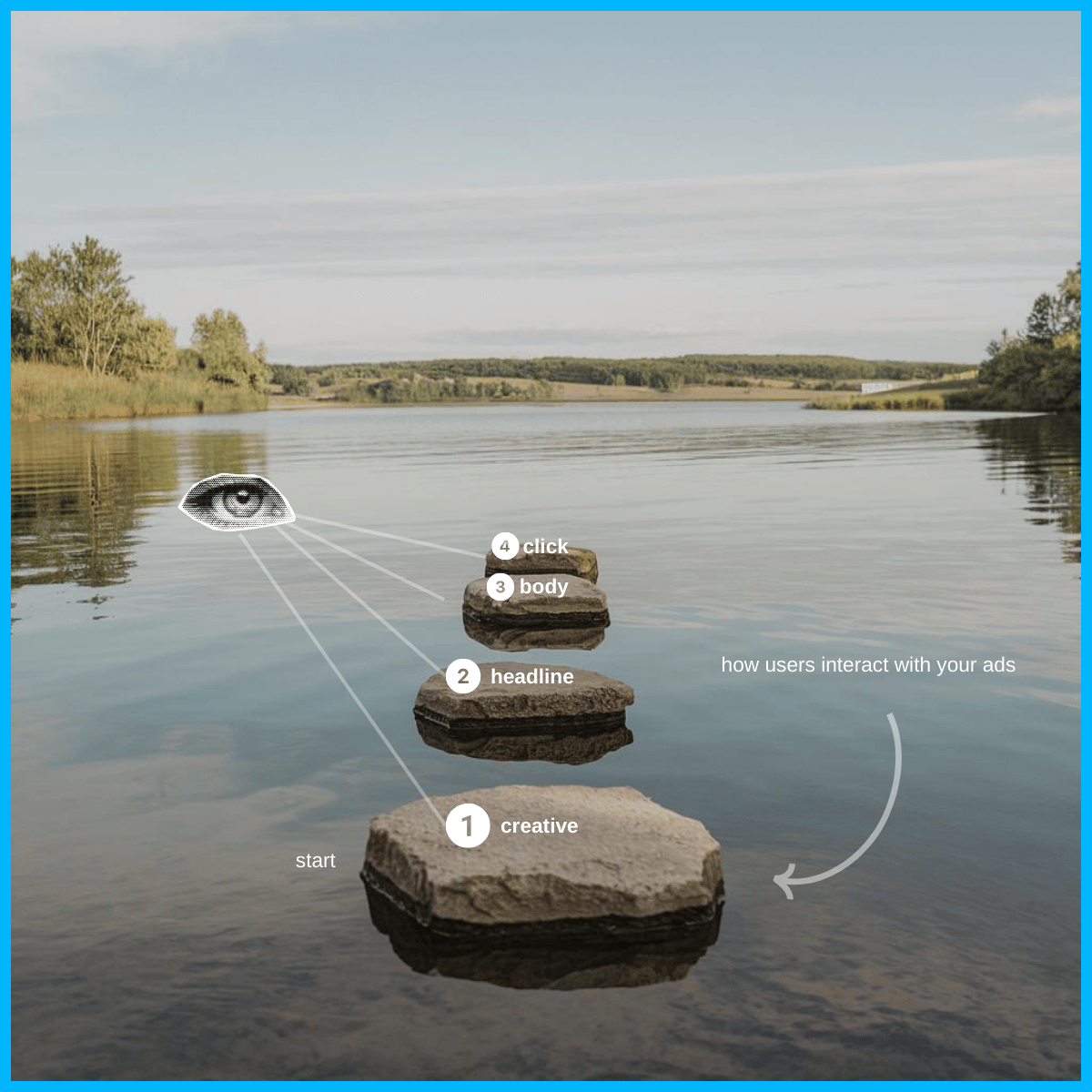
Pro tip: you can’t create ads in isolation, you need your designer and copywriter working together to ensure each variable in your ad works together (headline, body copy, creative).
Tip #5: Use The Slippery Slope
Your first line of copy should get the reader excited to read the second line. The second line should motivate the reader to read the third line. And so on. Direct marketer Joseph Sugarman calls this the “slippery slope”. It makes sure your ad is interesting to read and that the ideas inside it are easy to digest.
The best way to check and test your messaging for clarity and word choice is to read it out loud.
If you’re in the middle of a sentence and you paused for breath, you should place a period. That will help your sentences flow more naturally one into the other.
Tip #6: Don’t Be Afraid to Try Long Copy
I have a bone to pick with people who say “nobody reads online!” Because of course they don’t – if they don’t have something interesting to read.
People binge on Netflix series, video games, novel trilogies, and more for hours in one go.
When you have people's attention you can keep sharing with them new details. But you have to earn their attention, first. (Which won’t happen with clickbait.)
What can you give them in your ad that will make them feel they got value from this interaction, no matter how fleeting it was?
- Did they learn something new?
- Did you make them feel something?
- Did you make them think for a second?
If you can do at least one of those three things you’ll earn their attention.
It’s hard to do this in 150 characters which is why long form copy is so powerful.
Don’t be afraid to push up until that 600 character limit if needed.
Long copy will also lead to a greater dwell time and provide so much more context and opportunity for you to build motivation so they have a reason to click through.
The takeaway here is that people will read your long form ads if it’s interesting to them. But they won’t read even short copy if it’s terrible.
Side note: When writing ad copy I create 2-3 variations for the headline and the body, usually testing out different lengths (short vs long).
Here’s my simple but effective copywriting template I use in Google Docs:
LinkedIn ads template | Eden Bidani
Pro tip: it’s easy for ads to get stuck in the same creative loops, don’t forget to brainstorm new creative concepts to test.
Tip #7: Try to Use Your Voice of Customer As Much As Possible
If no one in the product marketing or CS team is interviewing your customers do this ASAP.
Get on a call with them and ask them questions such as:
- How do you use the product?
- What is the impact of your product?
The goal here isn’t to get testimonials, it’s to understand how your customers talk.
You’ll walk away knowing the benefits that matter to them and challenges.
I’d also recommend talking with sales and asking them what are the top customer objections that prospects say and exactly how they describe it.
Using the same words and language your customers use allows you to communicate in their voice.
These insights are so powerful that not even ChatGPT can brainstorm this for you.
For example I used to work with a company that created $700 work bags and I interviewed a customer that mentioned she used to carry around a “mom bag”.
What did she mean by that? “A shapeless, old ugly bag.”
That word “mom bag” is so unique and reflective of the voice of our customers that using that in our landing page copy instantly resonated and resulted in tremendous lifts in conversion rates.
Five customer interviews can be all it takes.
Tip #8: Clear Before Clever
Jay Abraham once said sometimes the easiest way to sell a horse is to say “horse for sale”.
You have a fleeting moment with your prospects engaging with your ads.
So even if you have to use specific, complicated terms (for your sophisticated audience) you need to focus on making your copy as clear as possible.
For example, try to simplify your language as much as possible. Yes, this might result in you using less voice of customer, or using a different brand tone of voice, and other elements of your messaging. But clear will always convert best.
Consider the words you are using and find synonyms that imply the same meaning with less cognitive load.
John Carlton refers to these as “power words” for example:
Sometimes you want to say fast but you should be saying swift.
Swift implies a very different connotation than fast.
It’s a whole different level of sophistication above “fast” but it’s still a simple word.
How would you say this same thing to a friend? Is a great frame to have.
Remember to avoid complicated and overdone words like omnichannel 🤮
Tip #9: Tie Benefits Back to Something Realistic
Everyone LOVES to talk about benefits – think: “Grow your business!”, “Transform your workplace!", “Win more customers!”, or “Optimize your life…!” 🙄
It’s not that it’s not true. They are. But they’re just so high-level and vague people struggle to grasp them. You need to tie them back to something tangible – something realistic that your prospects identify with. Otherwise, they just come off as fluff.
So make sure the claims you make in your ads are specific. And even better, back up your claims by connecting them to a feature or capability of your product.
Take the step to connect your benefits back to something realistic.
Pro tip: even better than talking about how your benefits connect to something realistic, SHOW PROSPECTS HOW this happens with supporting images or videos.
Tip #10: Make Sure Your Copy Passes the “So What” Test
You should be totally skeptical about your copy (just like prospects will be).
People aren’t stupid — even if they fall victim to clickbait they will bounce from your landing pages.
Every time you look at your copy ask yourself so what? And pick it apart to see where it’s fluff.
Sit back and look through to see where you’re missing proof points or what can be removed.
You’ll be able to find all those tiny things that will throw people off reading your ads.
At the end of the day your audience will look at the total sum of your ad (headline, body copy, creative) and if there are elements out of place such as:
- Run on sentences
- Improper formatting
- Typos and obvious errors
All of these details will affect whether the audience feels they can trust you with their click.
So what allows you a third person frame to find what looks off, and what can be stronger.
Pro tip: search for free ad mockup software on Google to find tools you can use to see what your copy will look like to your audience within the platform you’re advertising.
Hope you found this article helpful! 👏
Connect with me on LinkedIn and let’s keep the conversation going.
And if you’re in need of copywriting assistance check us out at CAPE Agency.
Resources for mastering B2B advertising
If you’re serious about mastering B2B advertising then you definitely need to join 1,000+ B2B marketers leveling up their paid advertising skill sets in AdConversion.
Here’s 4 reasons why you should consider joining. Every one of our on-demand courses are:
✅ 100% free access.
✅ Taught by vetted industry experts.
✅ Have workbooks, resources, and templates.
✅ Less than 10 minutes per lesson.
We believe every marketer should know how to scale paid ads so they can:
- Scale their ideas
- Level up their careers
- Make a positive impact
Click Here to Join 1,000+ B2B Marketers Today and start levelling up your advertising skill set.
Takes < 90 seconds to sign up (seriously we timed it 😂)

Join 1,000+ B2B marketers leveling up their paid advertising skill set! 🚀





%20-%20new%20v2.png)





